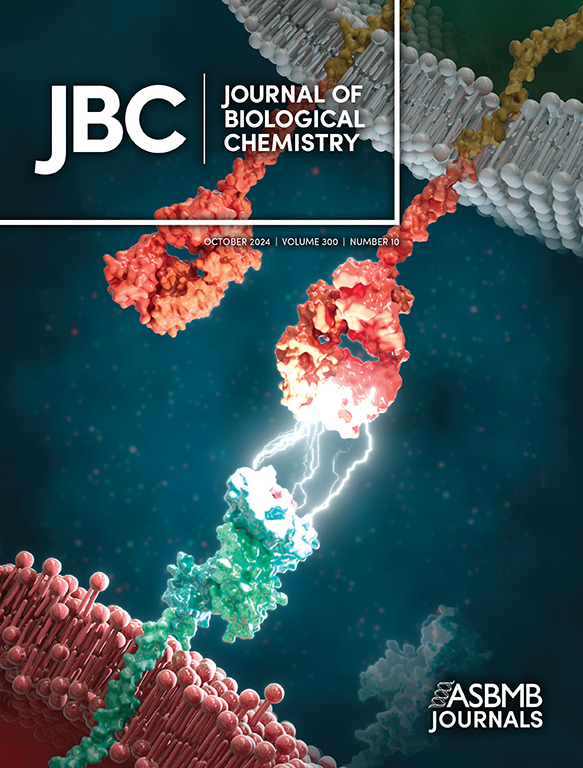Rag gtpase通过调节果蝇v- atp酶的组装来控制溶酶体酸化。
IF 4
2区 生物学
Q2 BIOCHEMISTRY & MOLECULAR BIOLOGY
引用次数: 0
摘要
Rag GTPases在感知氨基酸和激活rapamycin complex 1 (TORC1)靶标中发挥重要作用,TORC1是细胞代谢的主要调节因子。之前,我们已经证明,与gdp结合的RagA刺激溶酶体酸化和自噬降解,这对于果蝇在饥饿下的卵室存活至关重要。然而,潜在的机制尚不清楚。本研究表明,与gdp结合的RagA破坏了含有无尾复合体多肽1 (CCT)的伙伴蛋白与液泡H+- atp酶(v- atp酶)亚基V1之间的物理相互作用,从而促进了活性v- atp酶的组装,增加了溶酶体酸化。一致地,CCT复合物组分的敲除挽救了RagA RNAi中有缺陷的自溶酶体的积累。此外,将Rag gtpase固定在溶酶体上的溶酶体适配体、MAPK和mTOR激活剂(LAMTOR)的组成部分Lamtor4的敲低导致自溶酶体积累,这表明raggtpase调节溶酶体酸化依赖于它们的溶酶体定位。敲低CCT复合物组分可减轻Lamtor 4 RNAi的自噬缺陷。我们的工作强调了CCT和v- atp酶在调节溶酶体酸化中的相互作用。本文章由计算机程序翻译,如有差异,请以英文原文为准。
Rag GTPases control lysosomal acidification by regulating v-ATPase assembly in Drosophila.
The Rag GTPases play an important role in sensing amino acids and activating the target of rapamycin complex 1 (TORC1), a master regulator of cell metabolism. Previously, we have shown that GDP-bound RagA stimulates lysosome acidification and autophagic degradation, which are essential for young egg chamber survival under starvation in Drosophila. However, the underlying mechanism is unclear. Here we demonstrate that the GDP-bound RagA breaks the physical interaction between chaperonin containing tailless complex polypeptide 1 (CCT) and Vacuolar H+-ATPase (v-ATPase) subunit V1, and thus promotes the assembly of active v-ATPase and increases the lysosomal acidification. Consistently, knockdown of CCT complex components rescued the accumulation of defective autolysosomes in RagA RNAi. Moreover, the knockdown of Lamtor4, a component of lysosomal adaptor and MAPK and mTOR activator (LAMTOR) that anchors Rag GTPases to the lysosome, resulted in autolysosome accumulation, suggesting that RagGTPases regulate lysosomal acidification depend on their lysosomal localization. Knockdown of the CCT complex components attenuated the autophagic defects in Lamtor 4 RNAi. Our work highlights the interaction between CCT and v-ATPase in regulating lysosomal acidification.
求助全文
通过发布文献求助,成功后即可免费获取论文全文。
去求助
来源期刊

Journal of Biological Chemistry
Biochemistry, Genetics and Molecular Biology-Biochemistry
自引率
4.20%
发文量
1233
期刊介绍:
The Journal of Biological Chemistry welcomes high-quality science that seeks to elucidate the molecular and cellular basis of biological processes. Papers published in JBC can therefore fall under the umbrellas of not only biological chemistry, chemical biology, or biochemistry, but also allied disciplines such as biophysics, systems biology, RNA biology, immunology, microbiology, neurobiology, epigenetics, computational biology, ’omics, and many more. The outcome of our focus on papers that contribute novel and important mechanistic insights, rather than on a particular topic area, is that JBC is truly a melting pot for scientists across disciplines. In addition, JBC welcomes papers that describe methods that will help scientists push their biochemical inquiries forward and resources that will be of use to the research community.
 求助内容:
求助内容: 应助结果提醒方式:
应助结果提醒方式:


